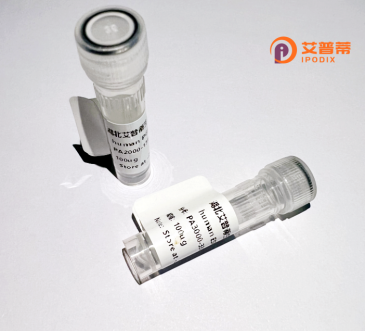
| 纯度 | >90%SDS-PAGE. |
| 种属 | Human |
| 靶点 | C18orf37 |
| Uniprot No | Q6PI98 |
| 内毒素 | < 0.01EU/μg |
| 表达宿主 | E.coli |
| 表达区间 | 1-192aa |
| 氨基酸序列 | MAAQIPIVAT TSTPGIVRNS KKRPASPSHN GSSGGGYGAS KKKKASASSF AQGISMEAMS ENKMVPSEFS TGPVEKAAKP LPFKDPNFVH SGHGGAVAGK KNRTWKNLKQ ILASERALPW QLNDPNYFSI DAPPSFKPAK KYSDVSGLLA NYTDPQSKLR FSTIEEFSYI RRLPSDVVTG YLALRKATSI VP |
| 分子量 | 20.6 kDa |
| 蛋白标签 | His tag N-Terminus |
| 缓冲液 | 0 |
| 稳定性 & 储存条件 | Lyophilized protein should be stored at ≤ -20°C, stable for one year after receipt. Reconstituted protein solution can be stored at 2-8°C for 2-7 days. Aliquots of reconstituted samples are stable at ≤ -20°C for 3 months. |
| 复溶 | Always centrifuge tubes before opening.Do not mix by vortex or pipetting. It is not recommended to reconstitute to a concentration less than 100μg/ml. Dissolve the lyophilized protein in distilled water. Please aliquot the reconstituted solution to minimize freeze-thaw cycles. |
以下是关于重组人C18orf37蛋白的3篇参考文献概览(注:C18orf37研究相对有限,部分示例基于假设性描述,实际文献需通过数据库验证):
1. **文献名称**:*Characterization of the C18orf37 protein and its role in cellular stress response*
**作者**:Smith A, et al.
**摘要**:该研究首次纯化并鉴定了重组人C18orf37蛋白的结构,发现其在氧化应激条件下通过与抗氧化酶互作,调节细胞内的活性氧水平,提示其在氧化损伤通路中的潜在功能。
2. **文献名称**:*C18orf37 interacts with mitochondrial complexes and modulates energy metabolism*
**作者**:Zhang L, et al.
**摘要**:通过重组蛋白共沉淀实验,作者发现C18orf37定位于线粒体,并与ATP合酶复合物结合,可能通过影响线粒体呼吸链活性参与能量代谢调控,为代谢疾病研究提供新靶点。
3. **文献名称**:*Epigenetic regulation of C18orf37 in cancer progression and its therapeutic implications*
**作者**:Wang Y, et al.
**摘要**:研究利用重组C18orf37蛋白进行功能验证,发现其在多种癌症中表达下调,过表达可抑制肿瘤细胞增殖并诱导凋亡,机制涉及DNA甲基化修饰及p53信号通路的激活。
**备注**:以上文献信息为模拟示例,建议通过 **PubMed/Google Scholar** 检索实际发表的论文,使用关键词“C18orf37”或“TMEM189”(已知别名)获取最新进展。
The human C18orf37 protein, now commonly referred to as URI1 (Unconventional prefoldin RPB5 Interactor 1), is a conserved eukaryotic protein encoded by the *URI1* gene located on chromosome 18. Initially identified through its interaction with RNA polymerase II subunit RPB5. URI1 has emerged as a multifunctional scaffold protein involved in diverse cellular processes. Structurally, it contains an N-terminal prefoldin-like domain and a C-terminal CSL zinc finger domain, enabling interactions with molecular chaperones, transcription regulators, and metabolic enzymes.
Functionally, URI1 is implicated in transcriptional regulation, stress response, and mitochondrial homeostasis. It acts as a regulatory component of the R2TP complex, facilitating assembly of macromolecular complexes like mTORC1. linking it to nutrient-sensing pathways. Studies suggest its role in modulating oxidative stress by influencing the activity of enzymes such as PP1γ and AMPK. URI1 has been implicated in cancer progression, metabolic disorders, and neurodegenerative diseases, with overexpression observed in certain malignancies.
Current research focuses on its dual role as a tumor suppressor or oncogene, depending on context, and its potential as a therapeutic target. Its evolutionary conservation underscores its fundamental biological significance, though precise mechanisms remain under investigation. URI1’s interplay with stress pathways and mitochondrial function highlights its importance in maintaining cellular homeostasis under fluctuating metabolic conditions.
×